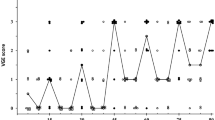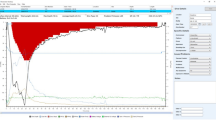Abstract
Aviation deep vein thrombosis is a challenge poorly understood in modern aviation. The aim of the present project was to determine if cabin decompression might favor formation of vascular bubbles in commercial air travelers. Thirty commercial flights were taken. Cabin pressure was noted at take-off and at every minute following, until the pressure stabilized. These time–pressure profiles were imported into the statistics program R and analyzed using the package SCUBA. Greatest pressure differentials between tissues and cabin pressures were estimated for 20, 40, 60, 80 and 120 min half-time compartments. Time to decompress ranged from 11 to 47 min. The greatest drop in cabin pressure was from 1022 to 776 mBar, equivalent to a saturated diver ascending from 2.46 msw depth. Mean pressure drop in flights >2 h duration was 193 mBar, while mean pressure drop in flights <2 h was 165 mBar. The greatest drop in pressure over 1 min was 28 mBar. Over 30 commercial flights it was found that the drop in cabin pressure was commensurate with that found to cause bubbles in man. Both the US Navy and the Royal Navy mandate far slower decompression from states of saturation, being 1.7 and 1.9 mBar/min respectively. The median overall rate of decompression found in this study was 8.5 mBar/min, five times the rate prescribed for USN saturation divers. The tissues associated with hypobaric bubble formation are likely slower than those associated with bounce diving, with 60 min a potentially useful index.

Similar content being viewed by others
References
Cannegieter SC (2012) Travel-related thrombosis. Best Pract Res Clin Haematol 25:345–350
Sandor T (2008) Travel thrombosis: pathomechanisms and clinical aspects. Pathophysiology 15:243–252
Schreijer AJM, Cannegieter SC, Meijers JCM, Middeldorp S, Buller HR, Rosendaal FR (2006) Activation of coagulation system during air travel: a crossover study. Lancet 367:832–838
Brubakk A, Ross JAS, Thom SR (2014) Saturation diving; physiology and pathophysiology. Compr Physiol 4:1229–1272
Wisloff U, Richardson RS, Brubakk AO (2004) Exercise and nitric oxide prevent bubble formation: a novel approach to the prevention of decompression sickness? J Physiol 555(Pt 3):825–829
Dujic Z, Duplancic D, Marinovic-Terzic I, Bakovic D, Ivancev V, Valic Z et al (2004) Aerobic exercise before diving reduces venous gas bubble formation in humans. J Physiol 555(Pt 3):637–642
Wisloff U, Richardson RS, Brubakk AO (2003) NOS inhibition increases bubble formation and reduces survival in sedentary but not exercised rats. J Physiol 546(Pt 2):577–582
Dujic Z, Palada I, Valic Z, Duplancic D, Obad A, Wisloff U et al (2006) Exogenous nitric oxide and bubble formation in divers. Med Sci Sports Exerc 38(8):1432–1435
Pontier JM, Blatteau JE, Vallee N (2008) Blood platelet count and severity of decompression sickness in rats after a provocative dive. Aviat Space Environ Med 79(8):761–764
Tanoue K, Mano Y, Kuroiwa K, Suzuki H, Shibayama M, Yamazaki H (1987) Consumption of platelets in decompression sickness of rabbits. J Appl Physiol 62(5):1772–1779
Domoto H, Nakabayashi K, Hashimoto A, Suzuki S, Kitamura T (2001) Decrease in platelet count during saturation diving. Aviat Space Environ Med 72(4):380–384
Pontier JM, Vallee N, Bourdon L (2009) Bubble-induced platelet aggregation in a rat model of decompression sickness. J Appl Physiol 107(6):1825–1829
Moon RE, Fawcett TA, Exposito AJ, Camporesi EM, Bennett PB, Holthaus J (1992) Platelet count in deep saturation diving. Undersea Biomed Res 19(4):279–286
Pontier JM, Vallee N, Ignatescu M, Bourdon L (2011) Pharmacological intervention against bubble-induced platelet aggregation in a rat model of decompression sickness. J Appl Physiol 110(3):724–729
Little T, Butler BD (2008) Pharmacological intervention to the inflammatory response from decompression sickness in rats. Aviat Space Environ Med 79(2):87–93
Lambrechts K, Pontier JM, Mazur A, Theron M, Buzaacott P, Wang Q et al (2015) Mechanism of action of antiplatelet drugs on decompression sickness in rats: a protective effect of anti-GPIIbIIIa therapy. J Appl Physiol 118:1234–1239
Cesarone MR, Belcaro G, Nicolaides AN, Incandela L, De Sanctis MT, Geroulakos G et al (2002) Venous thrombosis from air travel: the LONFLIT3 study. Angiology 53(1):1–6
Landolfi A, Yang ZJ, Savini F et al (2006) Pre-treatment with hyperbaric oxygenation reduces bubble formation and platelet activation. Sport Sci Health 1:122–128
Pendergast DR, Senf C, Lundgren CEG (2012) Is the rate of whole-body nitrogen elimination influenced by exercise? Undersea Hyperb Med 39(1):595–604
Eckenhoff RG, Olstad CS, Carrod G (1990) Human dose-response relationship for decompression and endogenous bubble formation. J Appl Physiol 69(3):914–918
Webb JT, Kannan N, Pilmanis AAIPAA (2003) Gender not a factor for altitude decompression sickness risk. Aviat Space Environ Med 74(1):2–10
Cialoni D, Pieri M, Balestra C, Marroni A (2015) Flying after diving: should recommendations be reviewed? In-flight echocardiography study in bubble-prone and bubble-resistant divers. Diving Hyperb Med 45(1):10–15
Eckenhoff RG, Osborne SF, Parker JW, Bondi KR (1986) Direct ascent from shallow air saturation exposures. Undersea Biomed Res 13(3):305–316
Gawthrope IC, Summers M, Macey DJ, Playford DA (2015) An observation of venous gas emboli in divers and susceptibility to decompression sickness. Diving Hyperb Med 45(1):25–28
Dixon GA, Krutz RWJ, Fischer JR (1988) Decompression sickness and bubble formation in females exposed to a simulated 7.8 psia suit environment. Aviat Space Environ Med 59(12):1146–1149
Buzzacott P, Papadopoulou V, Baddeley A, Petri NM, Lind F (2015) Theoretical tissue compartment inert gas pressures during a deep dive with and without deep decompression stops: a case analysis. Int Marit Health 66(1):36–42
Boycott AE, Damant GCC, Haldane JS (1908) The prevention of compressed air illness. J Hyg 8:342–443
Lambrechts K, Pontier J, Balestra C, Mazur A, Wang Q, Buzzacott P et al (2013) Effect of a single, open sea, air scuba dive on human micro- and macrovascular function. Eur J Appl Physiol 113:2637–2645
Lambrechts K, Pontier J, Mazur A, Buzzacott P, Morin J, Wang Q et al (2013) Effect of decompression-induced bubble formation on highly trained divers microvascular function. Physiol Rep 1(6):1–10
Lapostolle F, Surget V, Borron SW et al (2001) Severe pulmonary embolism associated with air travel. N Engl J Med 345:779–783
Wisloff U, Brubakk AO (2001) Aerobic endurance training reduces bubble formation and increases survival in rats exposed to hyperbaric pressure. J Physiol 537(Pt 2):607–611
Dujic Z, Valic Z, Brubakk AO (2008) Beneficial role of exercise on SCUBA diving. Exerc Sport Sci Rev 36(1):38–42
Zhang LD, Kang JF, Xue HL (1991) Ethanol treatment for acute decompression sickness. Undersea Biomed Res 18(1):64–67
Zhang LD, Kang JF, Xue HL (1989) Ethanol treatment for acute decompression sickness in rabbits. Undersea Biomed Res 16(4):271–274
Symington IS, Stack BHR (1977) Pulmonary thromboembolism after travel. Chest 17:138–140
Theunissen S, Balestra C, Boutros A, De Bels D, Guerrero F, Germonpre P (2015) The effect of pre-dive ingestion of dark chocolate on endothelial function after a scuba dive. Diving Hyperb Med 45(1):4–9
Obad A, Palada I, Valic Z, Ivancev V, Bakovic D, Wisloff U et al (2007) The effects of acute oral antioxidants on diving-induced alterations in human cardiovascular function. J Physiol 578(Pt 3):859–870
Acknowledgments
Peter Buzzacott is currently employed by the Divers Alert Network in North Carolina, USA. The photographs in Fig. 1 were taken by Carol Sugars and are reproduced with permission. The authors thank Professor Alf O. Brubakk for his insightful assistance at the commencement of this research.
Author information
Authors and Affiliations
Corresponding author
Rights and permissions
About this article
Cite this article
Buzzacott, P., Mollerlokken, A. Could some aviation deep vein thrombosis be a form of decompression sickness?. J Thromb Thrombolysis 42, 346–351 (2016). https://doi.org/10.1007/s11239-016-1368-x
Published:
Issue Date:
DOI: https://doi.org/10.1007/s11239-016-1368-x




